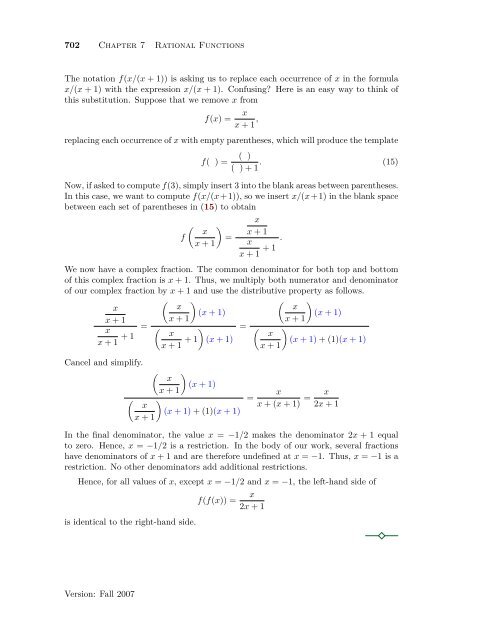Chapter 7 Rational Functions - College of the Redwoods
Chapter 7 Rational Functions - College of the Redwoods
Chapter 7 Rational Functions - College of the Redwoods
You also want an ePaper? Increase the reach of your titles
YUMPU automatically turns print PDFs into web optimized ePapers that Google loves.
702 <strong>Chapter</strong> 7 <strong>Rational</strong> <strong>Functions</strong><br />
The notation f(x/(x + 1)) is asking us to replace each occurrence <strong>of</strong> x in <strong>the</strong> formula<br />
x/(x + 1) with <strong>the</strong> expression x/(x + 1). Confusing? Here is an easy way to think <strong>of</strong><br />
this substitution. Suppose that we remove x from<br />
f(x) =<br />
x<br />
x + 1 ,<br />
replacing each occurrence <strong>of</strong> x with empty paren<strong>the</strong>ses, which will produce <strong>the</strong> template<br />
f( ) = ( )<br />
( ) + 1 . (15)<br />
Now, if asked to compute f(3), simply insert 3 into <strong>the</strong> blank areas between paren<strong>the</strong>ses.<br />
In this case, we want to compute f(x/(x+1)), so we insert x/(x+1) in <strong>the</strong> blank space<br />
between each set <strong>of</strong> paren<strong>the</strong>ses in (15) to obtain<br />
f<br />
( ) x<br />
=<br />
x + 1<br />
x<br />
x + 1<br />
x<br />
x + 1 + 1 .<br />
We now have a complex fraction. The common denominator for both top and bottom<br />
<strong>of</strong> this complex fraction is x + 1. Thus, we multiply both numerator and denominator<br />
<strong>of</strong> our complex fraction by x + 1 and use <strong>the</strong> distributive property as follows.<br />
x<br />
x + 1<br />
x<br />
x + 1 + 1 =<br />
( ) x<br />
(x + 1)<br />
x + 1<br />
( ) x<br />
x + 1 + 1 (x + 1)<br />
=<br />
( x<br />
x + 1<br />
( ) x<br />
(x + 1)<br />
x + 1<br />
)<br />
(x + 1) + (1)(x + 1)<br />
Cancel and simplify.<br />
( ) x<br />
(x + 1)<br />
x + 1<br />
( ) x<br />
(x + 1) + (1)(x + 1)<br />
x + 1<br />
=<br />
x<br />
x + (x + 1) =<br />
x<br />
2x + 1<br />
In <strong>the</strong> final denominator, <strong>the</strong> value x = −1/2 makes <strong>the</strong> denominator 2x + 1 equal<br />
to zero. Hence, x = −1/2 is a restriction. In <strong>the</strong> body <strong>of</strong> our work, several fractions<br />
have denominators <strong>of</strong> x + 1 and are <strong>the</strong>refore undefined at x = −1. Thus, x = −1 is a<br />
restriction. No o<strong>the</strong>r denominators add additional restrictions.<br />
Hence, for all values <strong>of</strong> x, except x = −1/2 and x = −1, <strong>the</strong> left-hand side <strong>of</strong><br />
f(f(x)) =<br />
x<br />
2x + 1<br />
is identical to <strong>the</strong> right-hand side.<br />
Version: Fall 2007

















